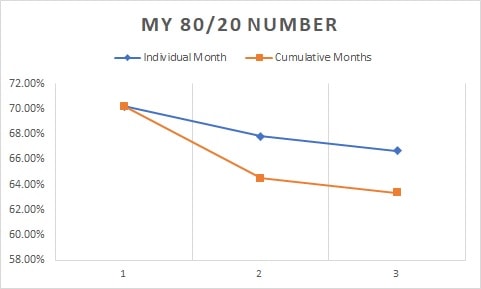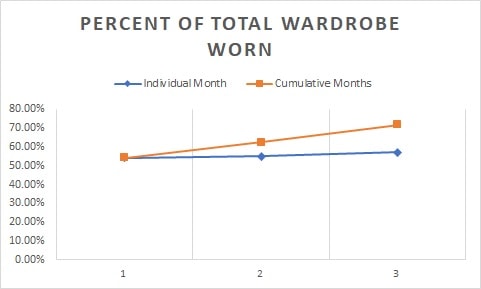
Since June 15, 2019 I have been tracking my clothes usage every single day with the help of Excel and an itemized list of every article of clothes that I own.
Why Would I Do This?
I read that we wear 20% of our clothes 80% of the time and I did not believe it. I looked for data online and found zero results offering the data that I was curious about. Seeing a lack of data, I decided to complete this experiment for myself and share my results with the world.
Why Does it Matter?
First and foremost, it matters to me and my intellectual curiosity. I had a question, I could not find the answer, so I am finding it out.
Digging deeper, the reason that I had this question is because people spend a lot of money on clothes and on their wardrobe. While buying clothes is a necessity and a basic human need to protect us against the elements, sometimes it goes too far and is inappropriate with respect to our financial means and goals.
I care deeply about being financially secure, not being in debt to anyone else, and being free to do whatever I want without having to worry about money. I am sure you want the same thing.
Unfortunately, this does not seem to be the case for the average American, and it is definitely not the case for people living in poorer economies. According to Forbes in an article published in 2018, of the people in the USA:
- 44% cannot cover a $400 emergency.
- 43% don’t make their student loan payments.
- 38% of households have credit card debt.
- 33% of adults have $0 saved for retirement.
A lack of basic financial management education in school, ease of acquiring debt, poor spending habits, and a need to appear wealthy (while not necessarily being wealthy) can all be looked to as possible reasons for this.
The good news is that you are in control of much of your finances. One area where you can make some serious impact is in your wardrobe and in your clothes spending habits.
How Much Do We Spend on Clothes?
According to Credit Donkey, the global apparel business is currently valued at 2.4 trillion dollars. That number, by the way, looks like this:
$2,400,000,000,000!
-Current value of the global apparel industry
So, much money is spent on clothes.
According to Financial Best Life, our clothes budget should be around 5% of our after-tax earnings. That actually seems pretty reasonable to me. As a reference for you, here is what 5% of various after-tax incomes would look like:
| After-Tax Income per Month | 5% Clothes Budget per Month |
| $1,000.00 | $50.00 |
| $1,500.00 | $75.00 |
| $2,000.00 | $100.00 |
| $2,500.00 | $125.00 |
| $3,000.00 | $150.00 |
| $3,500.00 | $175.00 |
| $4,000.00 | $200.00 |
| $4,500.00 | $225.00 |
| $5,000.00 | $250.00 |
| $5,500.00 | $275.00 |
| $6,000.00 | $300.00 |
How well are you sticking to this budget?
Credit Donkey shares some more interesting facts about our clothes spending:
- The average American spends about $161 per month on clothes.
- Middle aged people tend to spend about $50 more, but they also typically earn more money so the 5% rule instinctively makes sense (cents?).
- The average family spends $1,800 per year on clothes.
- The average person buys 7.8 pairs of shoes per year!
- Women aged 16 and older spend about 76% more on clothes then men of the same age.
- 9% of women have over $10,000 worth of clothes in their closets
- 32% of women own more than 25 pairs of shoes.
- 50%+ of women interviewed reported that over 25% of their wardrobe is never used.
- 73% of women update 25% of their wardrobe every 3 months
- 15% of women do not have any clothes older than 5 years
I don’t know about you, but some of these statistics seem shocking to me. Call me crazy, but I work hard for my money and I want to keep as much of it as possible. For me, that means not spending so much on my clothes and investing in myself in other ways.
Considering the financial health of many people and families, perhaps we should all spend a little less on our clothes, stick to the necessities, and limit the spending spree splurging on clothes shopping.
Why Do We Buy So Much?
Again, there is nothing wrong with buying clothes in-and-of-itself. We need clothes, so we should buy what we need. But what about all the extra clothes that we buy that we didn’t really need in the first place? Why do we buy it?
In this ABC News article, they claim that our spending habits can at least be partially explained by these reasons:
- It’s an immediate, short-term high
- The psychology of the sale makes people view the purchase as money saved, not as money spent. (WOW!)
This Pioneer of Class article reports that for women who go on shopping sprees, their main reasons for buying so much clothes are:
- 79% want to cheer themselves up
- 75% want to treat other people
- 61% feel that they are looking good
- 61% are feeling a bit low
- 53% are feeling happy
- 52% want to impress other people
- Read the article for the full list…
So, buying clothes is an immediate high fueled by persuasive marketing psychology which people claim cheers themselves up. Cool.
Unfortunately, that high wears off in time and we are left wondering why we are broke and why we have so much unused clothes in our wardrobes. We realize that we have been manipulated by the smartest marketers in the world.
Instead of cheering ourselves up, we now have a bunch of stuff that we don’t use, no money to cover a small $400 emergency, and no money put aside for retirement. Oh, and we also have credit card debt and student loan debt which we can’t get out of.
While this is clearly not the case for everyone, it is for many people. I care very much that I never put myself in this situation. I hope that you are not in this situation, either. There are many ways that we can cheer ourselves up besides buying clothes. Some of these options have more long-term positive effects, such as:
- Exercising
- Spending quality time with the people we care about (that doesn’t involve shopping)
- Being in nature
- Learning new skills
- Reading a book
- Watching our bank accounts and personal wealth increase
- Etc…
How about investing in these things, or whatever else makes you happy, instead of lining the pockets of an industry that already banks 2.4 trillion dollars a year!?
The Results of My Study
I began this study on June 15, 2019. Since then, my wardrobe has remained constant at 96 unique articles of clothes.
I have not purchased anything new for myself. And you know what? The world still turns, it has not negatively affected my life, and I have saved $483 compared to the average American. That is more than enough to cover a $400 emergency that so many Americans are unable to currently cover. The best part is that it only took me three months! YAY!
While my wardrobe is pretty small, I have still discovered that I wear 20% of my clothes:

| Month | 1 | 2 | 3 |
| Individual Month | 70.21% | 67.83% | 66.67% |
| Cumulative Months | 70.21% | 64.52% | 63.34% |
In small sample sizes of only 1 month, I still wear 20% of all of the clothes I own at least 66.67% of the time. Over the course of 3 months, I wear 20% of my clothes 63.34% of the time.
So even I, who only own 96 articles of clothing, can live perfectly well with very little. And of that very little, I usually only wear 20% of it.
As for the total percentage of all of the clothes I have worn in my wardrobe, it looks like this:

| Month | 1 | 2 | 3 |
| Individual Month | 54.17% | 55.21% | 57.29% |
| Cumulative Months | 54.17% | 62.50% | 71.88% |
Again, in small sample sizes I wear around 55% of all of my wardrobe each month. Over the course of cumulative months, however, this number is steadily climbing. As of the end of the 3rd month, I have worn 71.88% of all of the clothes in my wardrobe at least once.
Not bad, considering that 3 months is essentially just one season and that some of my fall and winter wardrobe should be getting used for the first time over the next few months.
Conclusions
I do not have much clothes, I mostly use the same 20% of my wardrobe, I have not purchased a single piece of apparel for myself in over three months, and life is good.
While a budget of 5% spent on clothes is pretty reasonable, that number can be reduced to 0% without negatively affecting your life, at least in the short-term.
I suspect that this saved money will add much more long-term freedom and happiness to your life than a few extra articles of clothing in your wardrobe.
YouTube Video
Watch the YouTube video I made about this article. Like, subscribe and hit the notification bell to get my regular video updates.
Want to Track Your Clothes Usage, Too?
I highly encourage you to think critically about your clothes usage and to find out if you can save some money in this area of your life.
What’s measured is what’s managed, right? So, let’s manage our clothes usage a little bit more. Here is an Excel document which you can use to begin your very own 80/20 experiment on your wardrobe.
Aside from itemizing your clothes and setting up the Excel document at the very beginning, this experiment requires little time on your part. Simply open up your Excel document each day and input the clothes that you wear.
It takes like a minute or two a day, plus an additional 10 minutes at the end of each month to analyze and review your results.
Take charge of your finances, and if evaluating your wardrobe and clothes spending habits were step 1, it would be a good first step.
My personal journey and experiment continues, so be on the lookout for another update after Month 4 is complete.
Until then,
I wish you all the best.
Related Questions
How many different articles of clothing do I wear each day? According to the data, I wear, on average, 10.82 unique articles of clothing each day. Let’s call that 11 different items from my wardrobe each day. Some of the items get reused in the morning and in the evening, like my pajamas. Others get used throughout the day, like my flip-flops. Others stay on for the majority of the day.
Regardless, I can expect to wear about 11 different things each day. I expect that number to increase in the fall and winter as it gets colder.
How can I better control my shopping behavior? Remember that shopping doesn’t make you happy, at least not in the long-term. Try keeping track of your personal 80/20 wardrobe number to see how much of your clothes you actually wear. Remember that, on average, you can save up $161 per month simply by not buying clothes. And at the very least, stick to your 5% after-tax clothes budget. Review the chart above and compare it to your current spending.

